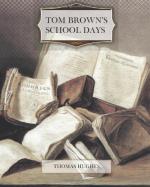Will you look for them under your own noses, or will you not? Well, well, I’ve done what I can to make you; and if you will go gadding over half Europe now, every holidays, I can’t help it. I was born and bred a west-country man, thank God! a Wessex man, a citizen of the noblest Saxon kingdom of Wessex, a regular “Angular Saxon,” the very soul of me adscriptus glebae. There’s nothing like the old country-side for me, and no music like the twang of the real old Saxon tongue, as one gets it fresh from the veritable chaw in the White Horse Vale; and I say with “Gaarge Ridler,” the old west-country yeoman,—
“Throo aall the
waarld owld Gaarge would bwoast,
Commend me to merry
owld England mwoast;
While vools gwoes prating
vur and nigh,
We stwops at whum, my
dog and I.”
Here, at any rate, lived and stopped at home Squire Brown, J.P. for the county of Berks, in a village near the foot of the White Horse range. And here he dealt out justice and mercy in a rough way, and begat sons and daughters, and hunted the fox, and grumbled at the badness of the roads and the times. And his wife dealt out stockings, and calico shirts, and smock frocks, and comforting drinks to the old folks with the “rheumatiz,” and good counsel to all; and kept the coal and clothes’ clubs going, for yule-tide, when the bands of mummers came round, dressed out in ribbons and coloured paper caps, and stamped round the Squire’s kitchen, repeating in true sing-song vernacular the legend of St. George and his fight, and the ten-pound doctor, who plays his part at healing the Saint—a relic, I believe, of the old Middle-age mysteries. It was the first dramatic representation which greeted the eyes of little Tom, who was brought down into the kitchen by his nurse to witness it, at the mature age of three years. Tom was the eldest child of his parents, and from his earliest babyhood exhibited the family characteristics in great strength. He was a hearty, strong boy from the first, given




